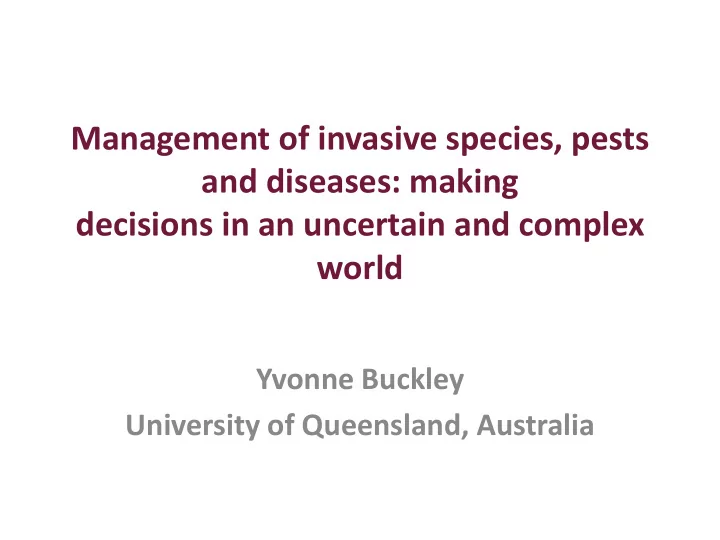

Management of invasive species, pests and diseases: making decisions in an uncertain and complex world Yvonne Buckley University of Queensland, Australia
Humans are the ultimate ecosystem engineers • Invasions • Extinctions • Climate change • Nitrogen deposition
Christmas Island
“Natural” ecosystems no longer exist Poa annua Poa pratensis Molina-Montenegro et al. 2012 Chown et al. 2012
Ecosystem function is affected by species identity, combinations and interactions • New combinations of traits • New interactions • New evolutionary selection pressures
Management of novel ecosystems • Ecosystem service provision – water, pollination, carbon • Food security – pasture management, weeds, pests • Conserve biodiversity for future generations
• Novel species interactions • Population responses to climate change • Spatial management of pests & diseases
Invasive Scotch Broom in New Zealand Honeybees + Pollination Scotch Broom, Cytisus scoparius
Seed set is pollinator limited Paynter, Main, Gourlay , Peterson, Fowler & Buckley 2010 Journal of Applied Ecology
Invasive Scotch Broom in New Zealand Beetle ( Bruchidius villosus ) Honeybees + Pollination - seed predation Scotch Broom, Cytisus scoparius
Invasive Scotch Broom in New Zealand Varroa destructor - Parasitism Beetle ( Bruchidius villosus ) Honeybees + Pollination - seed predation Scotch Broom, Cytisus scoparius
Pollinator disruption can enhance effects of biocontrol + bees - biocontrol + bees + biocontrol - bees - biocontrol - bees +biocontrol Paynter et al. 2010 Journal of Applied Ecology
Predicting the network level impact of plant species additions to pollinator networks Russo, Memmott, Montoya, Shea & Buckley (in review)
Models predicted network level metric response to species addition across a specialist-generalist gradient No. interactions SPECIALIST GENERALIST
Number of interactions & identity of links determines response of network
Novel species interactions are important for ecosystem function and stability We can use predictive models to estimate effects and inform management General theoretical expectations of how novel interactions affect network structure can be generated
Population responses to climate change • Altered abiotic conditions • Habitat suitability in current range will change • Areas outside current range may become suitable
Spread Dispersal Population dynamics Abiotic factors Biotic factors Vital rates: growth, Plant Traits survival, fecundity
Species Distribution Model Habitat suitability 0 1
Habitat suitability 0 1 Population dynamics & dispersal may respond in different ways to explanatory variables of Species Distribution Model
Current attempts to predict spread rates in response to novel conditions depend on assumptions of either: UNIFORMITY HETEROGENEITY Population dynamics Population dynamics ~ habitat suitability & dispersal constant within range boundaries
What do we know about spatial population dynamics and dispersal?
Key data sources for population dynamics • COMPADRE – plant population matrix models >850 species • COMADRE – animal population matrix models >1000 species Salguero-Gomez unpublished data
350 Oceania 300 Africa Asia 250 N America S America No. of species 200 150 Europe 100 50 0 1 2 3 4 5 6 7 8 9 10 20 30 40 50 More No. of spatial replicates per species
Spatial extent of population dynamic studies is limited 50% of species with both temporal and spatial replication use populations all within 1km (n=50 species, Buckley et al. 2010)
Spatial and temporal patterns in population growth rate are quite different: need to be cautious with space-time substitution
Astragalus Astragalus Arabis Hypericum scaphoides tyghensis fecunda cumulicola 1.0 1.5 1.5 0.4 0.8 1.0 0.2 1.0 0.6 0.5 log(lambda) log(lambda) log(lambda) log(lambda) 0.0 0.4 0.5 0.0 -0.2 Log(population growth rate) 0.2 -0.5 -0.4 0.0 0.0 -0.6 -1.0 -0.5 -0.2 1 2 3 4 5 1 2 3 4 5 6 1 2 3 4 5 2 4 6 8 Cimifuga Chamaecrista Aristida Astragalus Astragalus scaphoides Arabis fecunda Hypericum cumulicola Astragalus tyghensis elata keyensis bipartita alopecurus 0.5 0.5 0.6 0.4 0.4 0.0 0.3 0.3 0.4 log(lambda) log(lambda) log(lambda) log(lambda) 0.2 0.2 -0.5 0.2 0.1 0.1 0.0 0.0 0.0 -0.2 -0.1 -1.0 -0.1 1 2 3 4 5 1.0 1.5 2.0 2.5 3.0 1.0 1.5 2.0 2.5 3.0 3.5 4.0 1.0 1.5 2.0 2.5 3.0 3.5 4.0 Cimifuga_elata Chaemaecrista keyensis Aristida bipartita Astragalus alopecurus Time (years)
Knowledge of the geography of population dynamics at large spatial extents is limited Exploit analogs between Set up large scale, species invasions and species collaborative population movements in response to dynamics studies on a few climate change model species
Study of invasion broadens the spatial extent of population dynamics studies Invasions as analogs for species movement in response to climate change Caplat et al. in press, Oikos
Contemporary or historical invasions enable tests of theory relevant to predicting climate change responses
SPREAD Population Dispersal dynamics Abiotic environment Plant Traits
Seed terminal velocity, wind & demography determine spread. Caplat, Nathan & Buckley (2012) Ecology
Parameterisation from the field
Population vital rates and dispersal parameters determine spread speed 50 sensitivity of c* Sensitivity of spread rate 0 -50 -100 v t r j f h r h c s a s j U e s v t r j f h r H c s a s j Ū e s σ w k w k Ū σ Caplat et al. 2012 Ecology
Recommend
More recommend